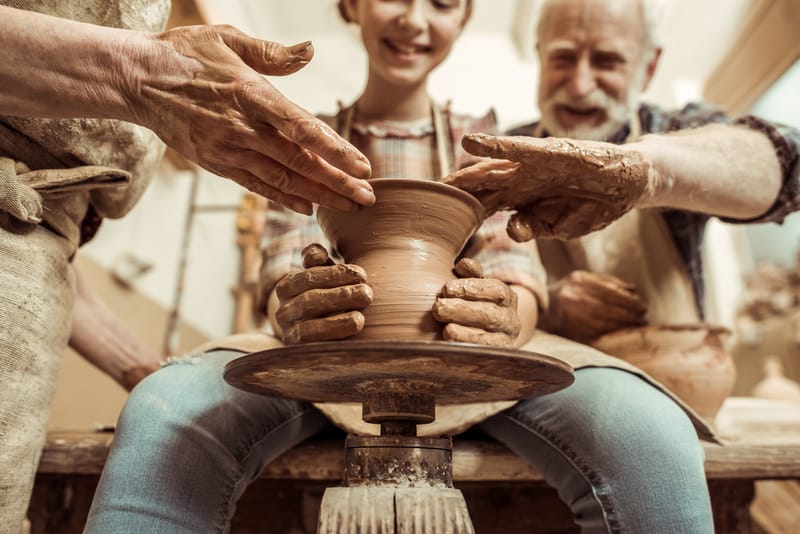Chronic obstructive pulmonary disease is a severe health condition that can affect people who have had long-term exposure to toxic gases, such as cigarette smoke. According to Chinese medicine, COPD should be avoided by reducing exposure to triggers such as smoking habits and toxic working conditions. The treatment of chronic obstructive pulmonary disease, according to TCM, involves the stimulation of acupressure points for COPD that will help to expel toxins from the body and improve Lung function.
What Is The Cause Of COPD?
Chronic obstructive pulmonary disease can be caused either by smoking, long-term exposure to toxic fumes or dust, and rarely by a genetic condition that causes the lungs to be very vulnerable to damage. In this condition, the lungs become inflamed and narrowed, obstructing the airflow.
Among the symptoms of COPD are shortness of breath, tightness in the chest, wheezing, productive cough, low energy, and swelling in the lower limbs. Usually, these symptoms are noticed when the disease is in its advanced stages, and the lungs have already been damaged. Unfortunately, the symptoms often worsen gradually over time, hindering the quality of life of patients who suffer from COPD.
Can Acupuncture Help COPD?

A multicenter, randomized, sham-controlled trial on the effects of acupuncture treatment for COPD carried out on 72 patients has found that after 8 weeks, the group who received real acupuncture for COPD exhibited significant improvements in quality of life compared with the sham acupuncture group. These effects are a good example of how the stimulation of acupressure points for COPD can be a suitable adjunctive therapy for some of the symptoms of chronic obstructive pulmonary disease.
In another study on sixty-eight patients in the Kansai region in Japan, acupuncture points for COPD were shown to help reduce dyspnea on exertion. These results were measured in terms of the Borg scale score, which was evaluated immediately after a 6-minute walk test. The Borg scale measures the intensity of physical activity. In this COPD-acupuncture trial, patients who received acupuncture also presented a significantly better exercise tolerance when compared to the patients who didn’t receive the treatment with acupuncture.
According to the World Health Organization, the chronic obstructive pulmonary disease is the third leading cause of death worldwide. The increased interest in acupuncture over the past years and the efforts in carrying out clinical trials on the effectiveness of acupuncture therapies is excellent news. The TCM approach is invaluable because it is a side-effect-free, unique treatment with a high efficacy rate.
What Are The Acupressure Points For COPD?
Acupoint: LU-9 (Other Names: Lung-9/Tai Yuan/Supreme Abyss)
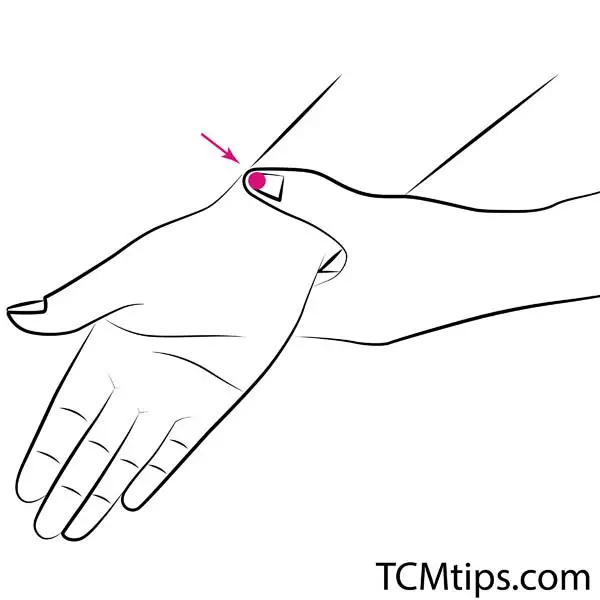
You can find LU-9 on the palmar side at the wrist joint, below your thumbs.
This acupoint is considered the most crucial point in the Lung meridian to treat severe conditions. In this single acupoint, the various branches of Qi meet and accumulate. It’s said to enhance both the nourishment and function of the Lungs and is the indicated acupoint to treat chronic conditions. Since the Qi of the entire body depends on the Lungs, this point is utilized to treat all disorders of Qi. The stimulation of this acupoint is expected to stop coughing, resolve Phlegm, alleviate pain, improve vital capacity, reduce inflammation and accelerate healing in the long run. This is one of the prominent pressure points in the chest area.
Massage your writs where LU-9 is located using your thumbs to apply pressure and movement for about three minutes daily. You can repeat this massage up to three times a day.
Acupoint: Ren-12 (Other Names: The Conception Vessel-12/Zhong Wan/Middle Epigastrium)

You can find this point on the midline of your abdomen, midway between the navel and the sternocostal angle.
Ren-12 is an important acupoint in the regulation of the digestive system. In TCM, many Lung problems are related to the digestive system’s improper functioning. This logic is becoming mainstream since many inflammatory processes are related to the foods we ingest, and COPD is an inflammatory condition. Therefore, the stimulation of Ren-12 is expected to improve digestion, nourish the body and transform Phlegm. This point is found in acupuncture for a brain tumors as well.
You can tap on this point using your fingers for about three minutes. Repeat this procedure throughout the day for an enhanced therapeutic effect.
Acupoint: ST-36 (Other Names: Stomach-36/Zu San Li/Leg Three Miles)

This acupoint is located one finger-breadth lateral to the crest of the tibia when you place your four fingers below your kneecap.
ST-36 is also called Zusanli. It is an essential point of the Stomach channel. It has many uses, from stomach pain to losing eyesight to low energy. It’s said that ST-36 can treat all diseases. The classical texts recommend that people over thirty do moxibustion on this acupoint daily to improve vitality and send energy to the eyes. Zusanli is especially connected to the upper torso, where the Lungs are located. The stimulation of this point is expected to improve well-being and vitality by enhancing the function of the Stomach and acting as a catalyzer of many different dynamics of Qi throughout the body. It’s one of the acupressure points for cough in children.
You can apply firm pressure at this acupoint using your thumbs for a few seconds, then release it briefly and repeat the procedure for about three minutes daily. Do this up to three times a day.
Acupoint: KI-3 (Other Names: Kidney-3/Tai Xi/Supreme Stream)
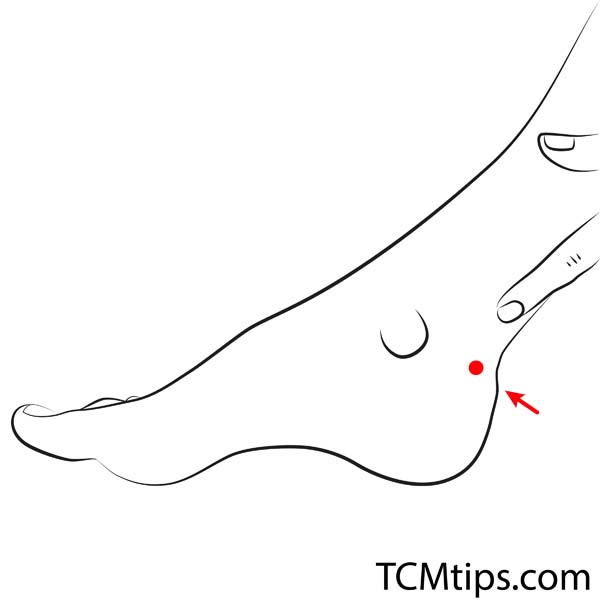
Taixi is located in the center of the depression between the medial malleolus and the posterior border of the Achilles tendon, level with the prominence of the malleolus.
KI-3 is a point where the Qi of the Kidney channel accumulates. Since the Qi of the Kidneys is said to provide motricity to the entire body, the stimulation of this acupoint has profound benefits. KI-3 deeply nourishes the whole body and especially the Lungs. The stimulation of this point is expected to improve dyspnoea, coughing, wheezing, and sputum with blood, besides regulating the uterus in women, and strengthening the lower back and knees, among other benefits. KI-3 is important in acupressure for dementia as well.
You can massage this point while in a sitting position by reaching your ankles with your hands and using your thumbs to apply pressure on this point for a few seconds, releasing intermittently for about three minutes. Repeat it up to three times daily.
Acupoint: GB-12 (Other Names: Gallbladder-12/Wan Gu/Mastoid Process)
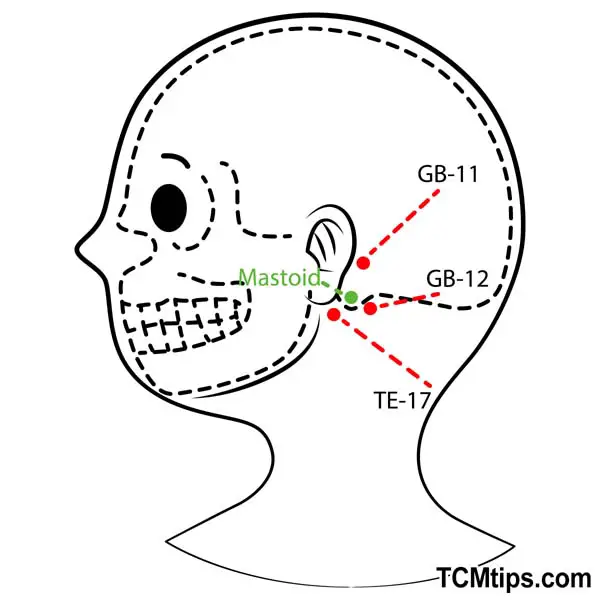
GB-12 is located in the hollow posterior and inferior to the mastoid process.
The action of this point is related to what is known in TCM as an invasion of Wind. The seasonal viral infections that attack the lungs are named Wind in TCM. This acupoint helps to eliminate alien agents from the Lungs. It is the meeting point of the Gall Bladder and Bladder channels. This point is also used in acupuncture for female pattern baldness.
Massage this acupoint with your fingers, applying pressure and movement for about three minutes daily.
Acupoint: BI-20 (Other Names: Urinary Bladder-20/Pi Shu/Spleen Transporter)
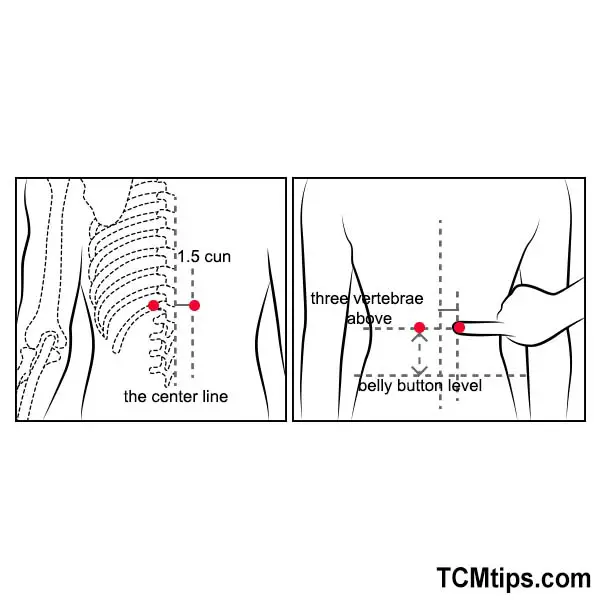
This point is located by placing two fingers on the side of the lower border of the 11th thoracic vertebrae, on the paravertebral muscle.
This acupoint is the command point to nourish and replenish the Spleen, which is considered a digestive organ in TCM. As mentioned in this article, digestive function is closely related to inflammatory processes in the body, mainly through the type of foods we ingest. Stimulating this acupoint helps regulate inflammatory responses in the body by strengthening the digestive system to avoid complications such as a leaky gut. The stimulation of this acupoint is expected to resolve Phlegm in the Lungs as well. Bl-20 is also one of the calming pressure points on babies.
Press this acupoint firmly for a few seconds, releasing it intermittently for about three minutes. Repeat this up to three times daily.
Takeaways
According to the World Health Organization, the chronic obstructive pulmonary disease is a severe condition and the third leading cause of death worldwide. The traditional treatment for this condition, according to TCM, involves stimulating specific acupressure points for COPD. The TCM approach of acupuncture has been shown to improve the quality of life in patients with COPD in the scientific studies where it was used. Furthermore, acupuncture treatment is free of adverse effects.
- LU-9 nourishes the Lungs, improving their function, reducing inflammation, and accelerating the healing process. It is the foremost among all acupressure points for breathing difficulties and also crucial among the acupressure points for shortness of breath.
- Ren-12 acts in the digestive system and resolves Phlegm.
- ST-36 has many functional effects and is an excellent overall health and energy booster. It’s greatly recommended for everyone over thirty who wants to maintain high energy levels and excellent health.
- KI-3 profoundly nourishes and restores the Inner Organs of the body. In addition, it has special benefits for the Lungs.
- GB-12 is a specific acupoint for respiratory infections, which may help with contamination in the Lungs. In addition, it is among the acupressure points for mucus in the throat.
- Bl-20 is said to replenish the function of the digestive system. Therefore, it is recommended in therapy for patients having Phlegm and inflammation related to a leaky gut condition.

Try our Anti-Aging Gua Sha Tool designed to bring out your skin’s natural glow.
Best Gua Sha Product- Anti-Aging: The tool is designed to target 11 specific aging signs such as wrinkles and sagging skin. By following the 7-step routine, users can improve skin firmness and reduce fine lines naturally.
- Enhances Skincare Routine: It works effectively with serums and lotions, boosting absorption and efficacy of skincare products.
- Visible Skin Improvement: Users can expect a smoother complexion, reduced puffiness, and a more youthful appearance.
 P. Sze
P. Sze 



